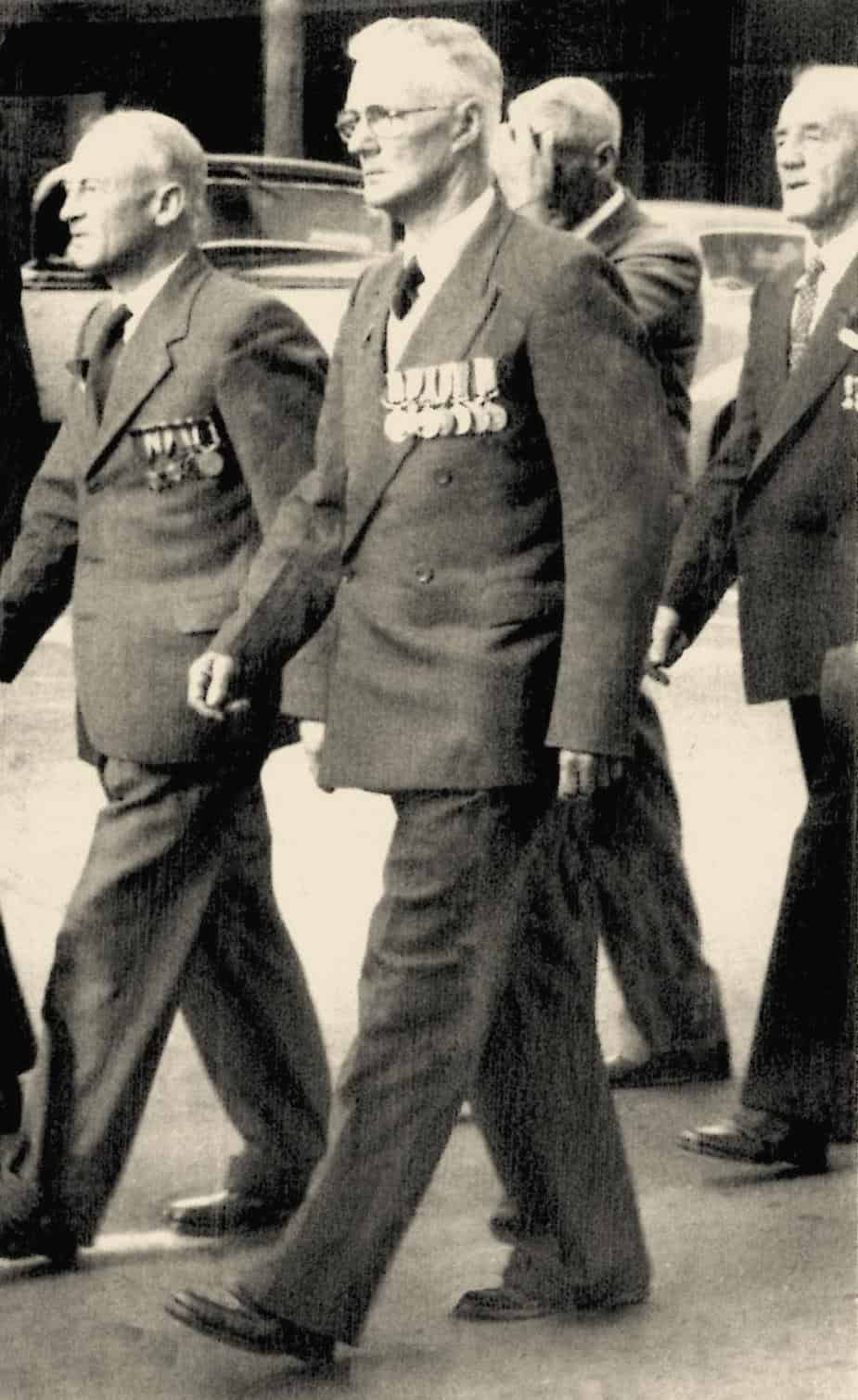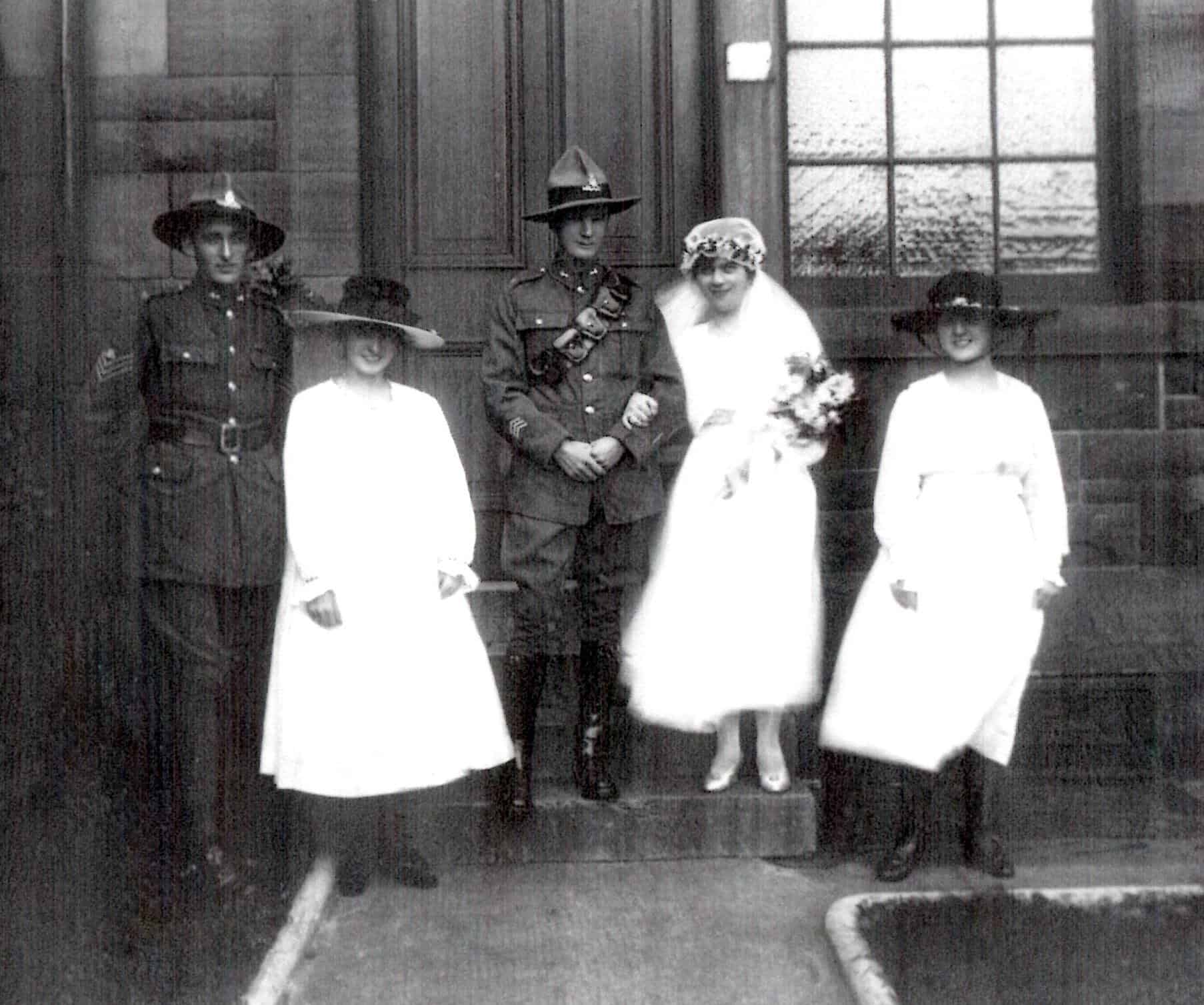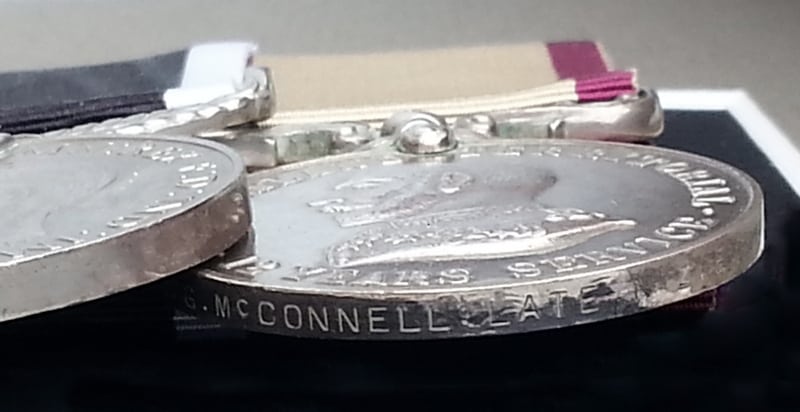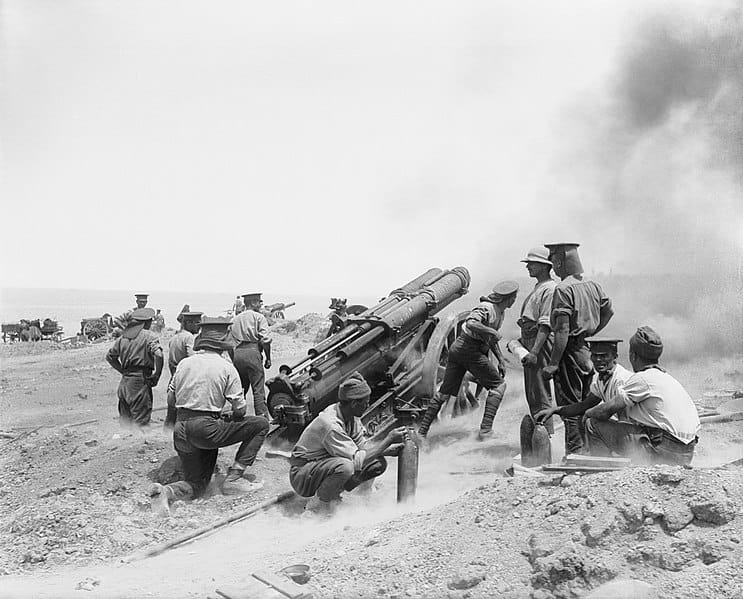2/436 ~ JOHN GRAHAM McCONNELL, MM
When a handsomely presented group of First and Second World War medals awarded to a New Zealand Artillery Gunner was posted on Trade-Me, the first medal in the group got my instant attention – it was a Military Medal (for gallantry). I am always astounded whenever I see a gallantry medal for sale, my immediate question being ‘how and why’ did such a medal become separated from the recipient’s family ownership? Of course we cannot always know the reasons which can be many and varied, sometimes instigated by the recipient, a descendant family member, or maybe circumstances beyond control. Whenever I do spot such medals for sale, if a New Zealander, I endeavour to find out how the disconnection from family ownership came about. In this particular case my research happily led to the medals being reunited with the McConnell family.
This research of this particular medal group started in the place Graham McConnell had died – Taradale, Napier. It was a relatively easy exercise to define the McConnell family structure from Ancestry and the Hawkes Bay Electoral Rolls however as most of the Graham McConnell’s immediate family were deceased, one critical piece of the puzzle remained unanswered until a connection was made in England. This led me to a resident of Onekawa, Napier. When I eventually made contact, I asked Graham McConnell’s son whether or not his father’s medals were in family ownership? “No” was his answer – it was then I learned why they were not !
To honour their father
Graham McConnell was a quiet, unassuming man, a carpenter-builder all his life who had lived for most of it in and around Napier. Graham had volunteered for WW1 service with the NZ Field Artillery, fresh from territorial service with the local Coastal Artillery unit, and went away with the Main Body to fight at Gallipoli and later in France on the Western Front. Having survived a wounding, and receiving a gallantry medal in the process, Graham returned to Napier in 1919 where he became a foundation member of the Taradale RSA. A tall and strikingly handsome man who carried himself with typical regimental pride, Graham was at his proudest when he joined with his cobbers on Anzac Day and marched through the streets of Napier. Never one to talk about his medals, it was plain to see by those who knew what Graham was wearing on his chest that he had been decorated for gallantry. As the years went by, ever a stalwart supporter of his RSA, Graham was invited to lead the Anzac Day parade during the last few years of his life, a job he felt particularly honoured and humbled to do despite his ageing frame resisting on occasions.

The McConnell family had always been very proud of their father’s military service, and particularly his winning of the Military Medal. Graham had gone away with the first troops to leave New Zealand (the Main Body) and hadn’t returned until well into 1919 after recuperating from wounds. Since he had been a foundation member of the Taradale RSA, after Graham passed away in 1982, eldest son Jack suggested to the rest of the family that their father’s medals be loaned to the Taradale RSA to be added to the medal display the club had inside its doors. Having their father’s medals displayed with the others Jack reasoned, would not only be a fitting tribute to their Dad but also a place where family, friends and patrons could enjoy the war hero’s medals at any time.
Going, going, GONE !
Mutually agreed, the McConnell family handed over Graham’s medals to the club’s medal display curator, an enthusiastic person who known to do some of the display’s preparatory work at home … and yes, you guessed it … this trusted member of management absconded with Graham McConnell’s medals along with numerous others he was allegedly ‘preparing’, never to be seen again!

I have to say I have lost count of the number of tales of woe related to me by distraught relatives who have had medals ‘vanish’ from an RSA. The days of RSAs being a trustworthy repository for veteran’s medals and military memorabilia delivered into their care, have well and truly gone. Until the 1970s it was not an uncommon practice for older war widows or families, particularly those who had no further descendants, to pass their deceased husband, son or grandfather’s war medals to their local RSA, secure in the (misguided) belief they would be cared for and secure ever after. Sadly this is no longer the case.
Medals and memorabilia were always welcomed in RSAs as it was a visible representation of a club’s raison d’etre and its membership. In earlier times, the RSA could assist an anguished widow or family member who was left with a deceased relatives medals and didn’t know what to do with them. This practice produced an accumulation of medals over the years, one which provided rich pickings for the unscrupulous who have had access to them. Poor inventory accounting practice together with the soaring value of medals in recent years has motivated numerous individuals help themselves for personal gain. Theft of medals from RSAs is legendary and remains an on-going source of national embarrassment.
In defence of the few RSAs who are fiercely conscious of their responsibility and diligent in the care and security of their holdings, these are a credit to their management and membership who clearly do whatever is necessary to ensure prevention. Unfortunately however, these also will be tarred with the same reputational brush as the offending clubs created by permitting the loss of taonga through ignorance and/or negligent accountability. It is a blessing that many of these RSAs have now closed their doors permanently but as long as clubs’ continue to hold medals and memorabilia, the risk will always remain.
~~~~~~~~~~~~~~~~~~~~~~~~~~
J. Graham McCONNELL
John Graham McConnell was born 10th May 1894 at Westshore, Napier. The son of John McConnell Jnr. (1865-1940), formerly a ship’s fireman and Napier fisherman, and Londonderry born Matilda CAMPBELL (1864-1926), John used his middle name “Graham” throughout his life to remove any confusion between himself and his father.
Graham’s first exposure to military training was in the School Cadet system. A Senior School Cadet at Napier Boys’ High School, compulsory military training occurred in schools from the age of 14 to 18. Once boys turned 18 they were required, by law, to transfer to an adult territorial unit to continue their training until the age of twenty one.
Empire’s Call to Arms
When New Zealand responded to a call from Great Britain for men to fight on the Western Front, it offered an Infantry Brigade (Rifle Battalions and Mounted Rifles Regiments) together with supporting arms such as Artillery, Engineers, Service Corps, Signals, Medical and so on. Volunteers were taken first from the existing territorial around the country with the residue forming the basis of future reinforcement drafts. There was no initial shortage of young men who were willing to fight.

At the time he enlisted on 4 August 1914, 2/436 Gunner Graham McConnell, NZFA was working as a carpenter for a local building firm in Napier.
The Main Body of the New Zealand Expeditionary Force comprised roughly 8500 soldiers, and 3000 horses, together with their associated equipment, left New Zealand on 16 October 1914 in a ten ship convoy. The convoy went first to Hobart and then to Albany in Western Australia where The New Zealanders joined a convoy of 28 Australian troopships. After 48 days including a stopover at Colombo (Sri Lanka), the convoy arrived not in England as they had anticipated before joining the fight against the Germans on the Western Front, but at the Alexandria, Egypt. As they quickly found out, their first task was to help protect the Suez Canal against attack by the forces of the Ottoman Empire, which had entered the war while the convoy was on the high seas.

Artillery units used wheeled cannon, known as field guns or howitzers, to destroy enemy forces and fortifications and clear obstacles such as barbed wire to enable infantry to advance. The artillery was the second-largest component of the New Zealand Expeditionary Force, after the infantry. Most artillerymen were attached to batteries of 18-pounder field guns, while a few used howitzers.
High-explosive and shrapnel shells fired by the artillery dominated First World War battlefields. They were a constant danger to soldiers in the trenches, and caused a steady stream of casualties. But it was prolonged bombardments that really shook men’s nerves. They often emerged from such episodes in a state of shock, numbed and hardly able to speak. Constant concussions and the fear of imminent oblivion by being blown to pieces, shattered by shell fragments or buried alive was almost impossible to bear, the worst cases being hospitalised with ‘shell shock’.
NZ Field Artillery
The NZ Field Artillery Brigade initially consisted of 185 men operating four field batteries. The 1st, 2nd and 3rd Batteries each had three or four 18-pounder medium field guns, and a 4th Battery with the same number of 4.5in heavy (Howitzer) field guns. Ammunition was replenished by a dedicated Brigade Ammunition Column (BAC) consisting of Drivers, horses and wagons to transport ammunition from ammo dumps to wherever the guns were located in the field. This was the organization the NZFA went to Gallipoli with. Gnr. McConnell was posted to the 3rd Battery and on 21 January 1915 was promoted to Acting Bombardier (Acting Cpl).
Manning the guns was dangerous work as artillery batteries were a priority target for enemy artillery to knock out because of their collective destructive firepower. For crews of the guns and men of the DAC, the danger came not only from direct attack on the gun positions, but also from the continual flying shrapnel that could travel hundreds of meters. An additional hazard for gunners also came from “premature” explosions of the shells. These most often occurred with a shell exploding inside the bore of a gun or just as it exited the barrel. ‘Prematures’ destroyed several guns and killed a number of men serving the guns or when delivering ammunition.
Gallipoli, 1915
A number of the NZFA men served on the peninsula for the entire nine month campaign but regrettably Gunner McConnell’s field operation records are missing from his file so we have no idea exactly where he was placed in the Gallipoli campaign. In July 1915, a second Artillery Brigade was added and became the basis of the NZ Divisional Field Artillery. The batteries were re-numbered: 1st Brigade – No’s 1 and 4 (Field Gun) Batteries, plus 6 (Howitzer) Battery; 2nd Brigade – No’s 2 and 5 (Field Gun) Batteries, plus 4 (Howitzer) Battery. Each brigade was served by a Field Gun and a Howitzer ammunition column. Collectively the ammunition column organization became the Divisional Ammunition Column (DAC). Trench Mortar Batteries (light and heavy) were also added to the Brigade organisation in 1916.

To the Western Front
Back in Alexandria after the successful night evacuation of the Peninsula by the ANZACs between 15-20 December the NZ Field Artillery Brigade was doubled in March to include a 3rd and 4th Brigade prior to the New Zealand Division’s move to France. The three batteries of the 1st Brigade were re-numbered: No’s 3, 5 and 7 (Field Gun) batteries, the 15th (Howitzer) Battery, plus the 1st Brigade Ammunition Column. They departed from Alexandria on 6 April 1916 as troop transports began to move the NZ Division to Marseilles. Gnr. McConnell remained in the 1st Brigade with No.3 Battery.
No guns, wagons or ammunition were taken as the batteries and ammunition columns were to be newly equipped in France. On arrival the troops were entrained for a 50 hour journey north through the French countryside to Havre where the NZFA was to be re-equipped before joining the Division in its billeting area near Hazebrouck. The Artillery was situated in and around small villages such as Lynde, Le Ciseaux, and Blaringhem. When training began, small parties of gunners from each brigade’s batteries were sent to Calais to familiarise themselves with the new weapons and to carry out live fire practices on ranges placed on the sea-front in preparation to take their place in the line at Armentieres.

The New Zealand artillery served with the New Zealand Division on the Western Front for the rest of the war, fighting at Messines and Passchendaele in 1917, against the Spring Offensive and in the Advance to Victory in 1918.
On 18 July 1916, Bombardier McConnell voluntarily relinquished his rank so he could remain with the guns. To remain a Bombardier would not only necessitate his undertaking a training course elsewhere, or an administrative or supervisory role elsewhere such as at the Brigade HQ?

The Somme, 1916
The Battle of the Somme was a series bitterly contested battles fought between 1 July and 18 Nov 1916. The official history of the NZ Field Artillery describes this period:

“October was a bad month for the batteries. It rained almost incessantly; the batteries were heavily shelled in their advanced and exposed positions and lost a great many of their personnel; and for the drivers and the men of the Ammunition Column, the journey to the guns was a nightly struggle against the elements; while since the departure of the rest of the Division the rations had become so meager and unvaried as to warrant the making of representations on the subject, after which there was an improvement. The enemy gunners harried the pack columns on the roads, and used their heavy guns unsparingly in the effort to destroy battery positions. With the absolute shortage of material and labour, nothing but splinter-proof shelters could be built at the most, and every battery suffered losses in guns and men, direct hits on the pits being suffered very frequently. In the 3rd Battery three direct hits were obtained on pits on October 3rd; and two days later, when the enemy shelled the area all day with 5.9in. and 8in. howitzers, a big shell landed on one pit, and destroyed the gun and ammunition, and killed the whole detachment”.
It was during one of these bombardments that Gnr. McConnell displayed the bravery that earned him the Military Medal.
MILITARY MEDAL
2/436 Gunner Graham McConnell, MM ~ 3rd Battery, 1st Brigade
NZ Field Artillery
Citation of the Award
During this action Gnr. McConnell was wounded in both head and face by flying shrapnel splinters. He was evacuated to the British 25th Stationary Hospital at Rouen and then on 6 October, embarked for England via hospital ship where he was admitted to the 1st Southern General Hospital at Birmingham.
Fortunately Gnr. McConnell did not have life threatening injuries. He was transferred a month later to convalesce at the NZ Base Depot’s Convalescent Camp at Codford. On 9 December he was discharged to the 3rd Reserve Battalion, Auckland-Wellington Regiment at Sling Camp.
Following his return from leave in January 1917, Gnr. McConnell left the NZ Field Artillery Depot at Aldershot and was transferred to the Reserve Company as a Driver with NZ Army Service Corps. Clearly impacted by the severity of his experiences during those desperate days on the Somme, a slightly less demanding role in England was considered appropriate for the young gunner until the end of the war.
Medals: Military Medal, 1914/15 Star, British War Medal, Victory Medal +Silver War Badge (SWB), Gallipoli Medallion (1967) & Lapel Badge + ANZAC Commemorative Medallion + Lapel Badge
Service Overseas: 4 years 155 days
Total NZEF Service: 4 years 247 days

Wedding Bells …
The gods must have been shining on Graham McConnell as he managed to find time to get married while overseas. On 18 September 1918 he married Miss Jane MORRISON (1896-1975), known as “Jean”, at Christ Church in Glasgow. Jean, one of four children born to John and Helen Morrison (nee McCAMON) came from Kircolm, Wigtown which is within the Dumfries and Galloway region of Scotland.

A concession accorded married soldiers after the war was to permit wives to return to New Zealand with their husbands on the troopships. Jean and Graham returned on HMNZT 222 Athenic which left Liverpool on 3 Feb 1919. Apart from having to undergo a final medical board on arrival back in NZ to insure his injuries had fully healed and no further medical attention was required, Graham McConnell was formally discharged from the NZEF on 17 April 1919.

Home again

On returning to New Zealand, Graham and Jean spent a year in Nelson where their first son “Jack” was born before returning to Graham’s home town of Napier, to a house in Charles Street, Westshore and a regular job once again as a Builder.

Note: ** The spelling variations between McConnell and MacConnell, the latter being the adopted style by Graham Campbell and Bruce Ralston MacConnell to reflect the original spelling of their grandfather, John MacConnell Jnr’s, surname.
Graham McConnell served with the NZ Army also during the Second World War. As 32173 Temporary Sergeant G. McConnell, NZ ASC he was mobilised in 1941 for Home Service as part of the National Military Reserve. The nature of his service is unknown due to the loss of records however was likely employed in a training role with the RNZA. For his continued Territorial Service before and after the First World War, Graham qualified in 1943 for the award of the NZ Territorial Service Medal (minimum 12 years service in the Territorial Force).
Medals: War Medal 1939/45, New Zealand War Service Medal, NZ Territorial Service Medal (1943)
A long and happy marriage preceded Graham’s retirement from the building trade. Settled at 10 Kauri Street in Taradale for the remainder of his days, John Graham McConnell, MM died on 26 June 1982, aged 88. Jean had pre-deceased Graham in 1975. His remains were interred in the Taradale Cemetery in a family grave with his parents and Graham and Jean’s wee boy Alastair.

Missing name ?

Putting together a basic family tree is generally not too hard. What is hard is finding out who the living members of a family are as the Privacy Act now prevents access via tools such as Ancestry. In the case of Graham McConnell’s family there was only one name, the youngest son whom I did not know which was a vital piece of the puzzle since he would be the most likely descendant in terms of seniority to be entitled to his father’s medals. Scanning the net using the two different spellings the McConnell family had applied, was in conclusive. Since I did not have the youngest sons name, I took the long road by talking to other people who had the McConnell’s in their family trees. One standout was Alasdair Morrison, a UK resident and relative of Graham’s wife Jean Morrison whose Morrison/Carnegie family tree was the ticket to success.

Alasdair could not have been more helpful. Not only was he able to furnish the missing name I was looking for but also provided some great historical photographs of the young Gunner Graham McConnell in uniform, including one of his wedding day in Glasgow. Photographs of those I write about are often the hardest item to acquire as not everyone that went to the war had access to photography or could afford it. Fortunately for me Alasdair had acquired the pictures from Brice’s daughter Anne, during a visit to NZ some years ago while researching the Morrison family’s ancestry. He also very kindly sent several hard copies of the photographs and dispatched these over Christmas. Unfortunately the postal system failed miserably on this occasion in that the envelope bearing the photographs had unbelievable been immersed in water somewhere during its journey from the UK. When I opened the envelope the photographic emulsion on the photos had partially dissolved and ‘glued’ each print together making them unsalvageable. I was more disappointed for Alasdair as he had gone to the trouble of having the pictures printed and posted. Electronic copies soon followed which actually proved to be a much better option as I was able to digitally improve the photographs by removing many of the imperfections and lighten/darken as required for better detail definition.
~~~~~~~~~~~~~~~~~~~~~~~~~~
I am pleased to report Bruce is now in possession of his father’s medals, secured once more in family ownership for future generations of McConnells. Just as well Graham had not been around to learn of the theft of his medals!

~~~~~~~~~~~~~~~~~~~~~~~~~~~
Sincere thanks to Alasdair346 (Morrison) from Cheltenham, Gloucestershire whose kind assistance has enhanced this reunited medals post with the photographs of Graham and Jean.
The reunited medal tally is now 455.














